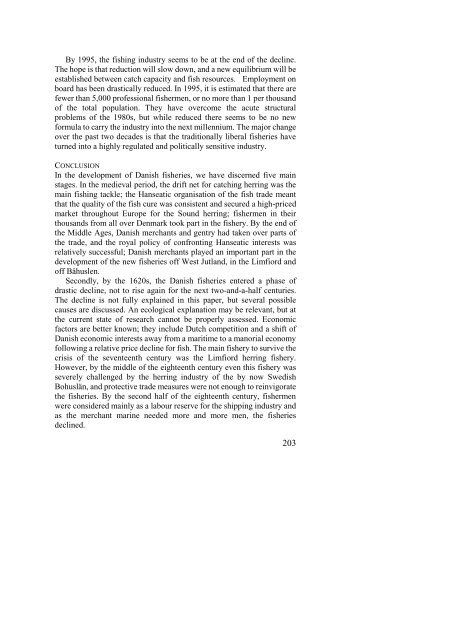The North Atlantic Fisheries, 1100-1976 - University of Hull
The North Atlantic Fisheries, 1100-1976 - University of Hull
The North Atlantic Fisheries, 1100-1976 - University of Hull
You also want an ePaper? Increase the reach of your titles
YUMPU automatically turns print PDFs into web optimized ePapers that Google loves.
By 1995, the fishing industry seems to be at the end <strong>of</strong> the decline.<br />
<strong>The</strong> hope is that reduction will slow down, and a new equilibrium will be<br />
established between catch capacity and fish resources. Employment on<br />
board has been drastically reduced. In 1995, it is estimated that there are<br />
fewer than 5,000 pr<strong>of</strong>essional fishermen, or no more than 1 per thousand<br />
<strong>of</strong> the total population. <strong>The</strong>y have overcome the acute structural<br />
problems <strong>of</strong> the 1980s, but while reduced there seems to be no new<br />
formula to carry the industry into the next millennium. <strong>The</strong> major change<br />
over the past two decades is that the traditionally liberal fisheries have<br />
turned into a highly regulated and politically sensitive industry.<br />
CONCLUSION<br />
In the development <strong>of</strong> Danish fisheries, we have discerned five main<br />
stages. In the medieval period, the drift net for catching herring was the<br />
main fishing tackle; the Hanseatic organisation <strong>of</strong> the fish trade meant<br />
that the quality <strong>of</strong> the fish cure was consistent and secured a high-priced<br />
market throughout Europe for the Sound herring; fishermen in their<br />
thousands from all over Denmark took part in the fishery. By the end <strong>of</strong><br />
the Middle Ages, Danish merchants and gentry had taken over parts <strong>of</strong><br />
the trade, and the royal policy <strong>of</strong> confronting Hanseatic interests was<br />
relatively successful; Danish merchants played an important part in the<br />
development <strong>of</strong> the new fisheries <strong>of</strong>f West Jutland, in the Limfiord and<br />
<strong>of</strong>f Båhuslen.<br />
Secondly, by the 1620s, the Danish fisheries entered a phase <strong>of</strong><br />
drastic decline, not to rise again for the next two-and-a-half centuries.<br />
<strong>The</strong> decline is not fully explained in this paper, but several possible<br />
causes are discussed. An ecological explanation may be relevant, but at<br />
the current state <strong>of</strong> research cannot be properly assessed. Economic<br />
factors are better known; they include Dutch competition and a shift <strong>of</strong><br />
Danish economic interests away from a maritime to a manorial economy<br />
following a relative price decline for fish. <strong>The</strong> main fishery to survive the<br />
crisis <strong>of</strong> the seventeenth century was the Limfiord herring fishery.<br />
However, by the middle <strong>of</strong> the eighteenth century even this fishery was<br />
severely challenged by the herring industry <strong>of</strong> the by now Swedish<br />
Bohuslän, and protective trade measures were not enough to reinvigorate<br />
the fisheries. By the second half <strong>of</strong> the eighteenth century, fishermen<br />
were considered mainly as a labour reserve for the shipping industry and<br />
as the merchant marine needed more and more men, the fisheries<br />
declined.<br />
203















